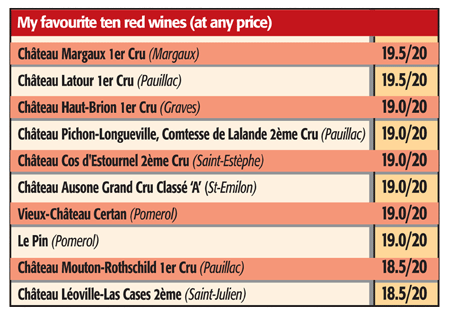
It is a bizarre feeling when you board EasyJet at that hellhole Luton airport and find the entire UK wine trade lined up, awaiting the annual Bordeaux en primeur tasting frenzy – the single most important week of wine tasting on the journalist’s calendar. I launched into four days of gripping tasting, determined, as every year, to nail the character of this vintage, to find the stars and identify the chateaux who should have done far better!
After filling in more than 100 A4 equivalent pages with notes it is my opinion that this is a very good vintage. Once we would have to wait four or five years for one of these to come along, but technical know-how, global warming and sheer terror of failure is working in our favour. A lot of money is spent buying Bordeaux futures, while wine lovers and wine brokers await the release of the prices of these wines chateau by chateau over the next few weeks. This is after all the single most important wine region in the world.
My job for you, the MoneyWeek reader, is to advise where you should be spending your money. You will no doubt have your preferred merchant who you can phone with a wish list once you have read this article. There is a lot of wine in Bordeaux, but worldwide demand grows every year and while Château Latour may well make a fairly hefty 10,000 cases (this is far more than a tiny Burgundy domaine, for example), this is a dribble bearing in mind the planet’s thirst for this style of wine.
Below, I have listed my top ten wines regardless of price and those that should end up (cross fingers) as worthwhile and great value purchases. In the meantime, you might like to ponder these thoughts:
– Prices must fall from the ballistic 2005s, 25%-50% in some cases, to restore some parity (and continued interest) in this self-important wine region. Customers spent a lot of money last year on 2005s. If they are to dip into their savings and bonuses this year, they need a compelling reason to do so. The French expression qualité prix sums it up – in English, value for money without dropping your standards.
– The rains in September caused rot and other issues for the vines. So the difference between success and mediocrity came down to selection. If you used your table de triage (selecting table – where substandard grapes are picked out before they make it to the winery, when the process is repeated), you will end up with a very good base crop with which to make a superb wine. This, in the most fastidious chateaux, meant sacrificing up to a third of the grapes. This may be a sizeable loss of money, but it is an investment in the buyers’ palates and bolsters the winemaker’s credentials in the long term. I spotted the honest producers a mile off. These are my top-scoring wines; they are the people who truly care about their integrity, your pleasure and that of your guests.
– Robin Kick, wine buyer for London’s Goedhuis & Co, 020-7793 7900, says: “The most successful communes… are St-Julien and Pauillac, but there are chateaux like Vieux Château Certan, Haut-Brion and others that have made stunning wines, so it’s not a simple case of relying on a few key areas. You have to do the hard yards – this is a vintage where we have to go back to grass roots and taste, taste, taste.” Tom Stopford-Sackville, MD at Goedhuis, goes further. “This is a winemaker’s vintage – you need the desire to make a great wine and this is only achieved by ruthless selection. Pontet-Canet is a case in point,” he says.
Matthew Jukes is author of The Wine List 2007: The Top 250 Wines of the Year (£9.99, Headline)